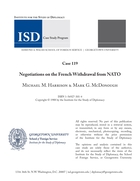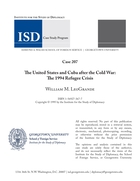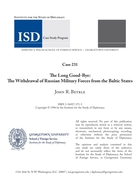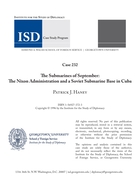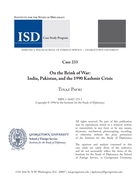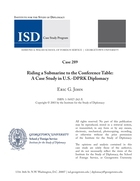Browse Titles - 10 results
Negotiations on the French Withdrawal from NATO
written by Mark G. McDonough, fl. 1988 and M. John Harrison, 1945-, in Institute for the Study of Diplomacy Case Study Program, Case 119 (District of Columbia: Georgetown University. School of Foreign Service. Institute for the Study of Diplomacy, 1988), 21 page(s)
This case study describes the negotiations accompanying the process of France’s withdrawal from the North Atlantic Treaty Organization’s integrated military system, including the expulsion of NATO units from French soil. It focuses on negotiations among allies who retain common political security interests, de...
Sample
written by Mark G. McDonough, fl. 1988 and M. John Harrison, 1945-, in Institute for the Study of Diplomacy Case Study Program, Case 119 (District of Columbia: Georgetown University. School of Foreign Service. Institute for the Study of Diplomacy, 1988), 21 page(s)
Description
This case study describes the negotiations accompanying the process of France’s withdrawal from the North Atlantic Treaty Organization’s integrated military system, including the expulsion of NATO units from French soil. It focuses on negotiations among allies who retain common political security interests, despite some strong differences concerning principles of national and Western defense. As such, the case is particularly useful for cours...
This case study describes the negotiations accompanying the process of France’s withdrawal from the North Atlantic Treaty Organization’s integrated military system, including the expulsion of NATO units from French soil. It focuses on negotiations among allies who retain common political security interests, despite some strong differences concerning principles of national and Western defense. As such, the case is particularly useful for courses on international negotiation and bargaining, and for courses involving alliance organizations and Western security affairs.
Show more
Show less
Field of Study
Global Issues
Content Type
Case study
Author / Creator
Mark G. McDonough, fl. 1988, M. John Harrison, 1945-
Date Published / Released
1988
Publisher
Georgetown University. School of Foreign Service. Institute for the Study of Diplomacy
Series
Institute for the Study of Diplomacy Case Study Program
Person Discussed
Charles de Gaulle, 1890-1970
Topic / Theme
France and its Borders, Negotiation in government, Military alliances, International relations, Civil defense, Politics & Policy, British, Americans, French, 20th Century in World History (1914--2000)
Copyright Message
Copyright © 1988 The Institute for the Study of Diplomacy
×
The United States and Cuba after the Cold War: The 1994 Refugee Crisis
written by William M. LeoGrande, fl. 1986, in Institute for the Study of Diplomacy Case Study Program, Case 207 (District of Columbia: Georgetown University. School of Foreign Service. Institute for the Study of Diplomacy, 1995), 17 page(s)
This case study examines the Clinton administration’s response to the rapid influx of Cuban refugees into the United States in 1994. Part A describes U.S.-Cuban relations during the Cold War, the roots of the 1994 refugee crisis, and the dilemma the Clinton administration faced as it sought to resolve this probl...
Sample
written by William M. LeoGrande, fl. 1986, in Institute for the Study of Diplomacy Case Study Program, Case 207 (District of Columbia: Georgetown University. School of Foreign Service. Institute for the Study of Diplomacy, 1995), 17 page(s)
Description
This case study examines the Clinton administration’s response to the rapid influx of Cuban refugees into the United States in 1994. Part A describes U.S.-Cuban relations during the Cold War, the roots of the 1994 refugee crisis, and the dilemma the Clinton administration faced as it sought to resolve this problem. Part B examines the administration’s response, and the outcome of the U.S.-Cuban negotiations to staunch the flow of refugees int...
This case study examines the Clinton administration’s response to the rapid influx of Cuban refugees into the United States in 1994. Part A describes U.S.-Cuban relations during the Cold War, the roots of the 1994 refugee crisis, and the dilemma the Clinton administration faced as it sought to resolve this problem. Part B examines the administration’s response, and the outcome of the U.S.-Cuban negotiations to staunch the flow of refugees into the United States. The case can be used in courses on international relations or foreign policy, and to illustrate the dynamics of crisis management.
Show more
Show less
Field of Study
Global Issues
Content Type
Case study
Author / Creator
William M. LeoGrande, fl. 1986
Date Published / Released
1995
Publisher
Georgetown University. School of Foreign Service. Institute for the Study of Diplomacy
Series
Institute for the Study of Diplomacy Case Study Program
Person Discussed
Lawton Mainor Chiles, Jr., 1930-1998, Janet Reno, 1938-2016, John F. Kennedy, 1917-1963, Fulgencio Batista, 1901-1973, Fidel Castro, 1926-2016, William Jefferson Clinton, 1946-
Topic / Theme
Sea Migrations, Cuba and the United States Border, Immigration laws, International relations, Crisis management, Negotiation in government, Refugees, Government policy, United States Imposes Embargo Against Cuba, October 19, 1960, Cuban Revolution, 1956-1959, Cuban Missile Crisis, 1962, Cold War, 1945-1989, Law, Politics & Policy, Americans, Cubans, Russians, 20th Century in World History (1914--2...
Sea Migrations, Cuba and the United States Border, Immigration laws, International relations, Crisis management, Negotiation in government, Refugees, Government policy, United States Imposes Embargo Against Cuba, October 19, 1960, Cuban Revolution, 1956-1959, Cuban Missile Crisis, 1962, Cold War, 1945-1989, Law, Politics & Policy, Americans, Cubans, Russians, 20th Century in World History (1914--2000)
Show more
Show less
Copyright Message
Copyright © 1995 The Institute for the Study of Diplomacy
×
The Dominican Intervention of 1965
written by Linda Head Flanagan, fl. 1995 and William Rosenau, fl. 1995, in Institute for the Study of Diplomacy Case Study Program, Case 208 (District of Columbia: Georgetown University. School of Foreign Service. Institute for the Study of Diplomacy, 1995), 13 page(s)
This case study examines the 1965 U.S. intervention in the Dominican Republic from the military point of view. U.S. troops were expected to actively oppose rebel forces; yet soon had to shift their mindset and become impartial guardians of order—that is, to engage in “stability” operations. The focus on mili...
Sample
written by Linda Head Flanagan, fl. 1995 and William Rosenau, fl. 1995, in Institute for the Study of Diplomacy Case Study Program, Case 208 (District of Columbia: Georgetown University. School of Foreign Service. Institute for the Study of Diplomacy, 1995), 13 page(s)
Description
This case study examines the 1965 U.S. intervention in the Dominican Republic from the military point of view. U.S. troops were expected to actively oppose rebel forces; yet soon had to shift their mindset and become impartial guardians of order—that is, to engage in “stability” operations. The focus on military missions and rules of engagement provides a useful counterexample to the U.S.-led, U.N.-sanctioned international intervention in S...
This case study examines the 1965 U.S. intervention in the Dominican Republic from the military point of view. U.S. troops were expected to actively oppose rebel forces; yet soon had to shift their mindset and become impartial guardians of order—that is, to engage in “stability” operations. The focus on military missions and rules of engagement provides a useful counterexample to the U.S.-led, U.N.-sanctioned international intervention in Somalia (1992-1994). It could also be used to examine U.S. policy in the developing world, particularly Latin America, or issues surrounding peacekeeping operations. The case can be assigned with “Operation Restore Hope: The Bush Administration's Decision to Intervene in Somalia” (Case Study 210); and “Key Decisions in the Somalia Intervention” (Case Study 211).
Show more
Show less
Field of Study
Global Issues
Content Type
Case study
Author / Creator
Linda Head Flanagan, fl. 1995, William Rosenau, fl. 1995
Date Published / Released
1995
Publisher
Georgetown University. School of Foreign Service. Institute for the Study of Diplomacy
Series
Institute for the Study of Diplomacy Case Study Program
Person Discussed
Héctor García-Godoy, 1921-1970, Lyndon B. Johnson, 1908-1973, Bruce Palmer, Jr., 1913-2000
Topic / Theme
Dominican Republic and Haiti Border, International relations, Peacekeeping, Government policy, Rebellions, Military campaigns, Dominican Civil War, April 24, 1965-September 3, 1965, Politics & Policy, Americans, Dominicans, 20th Century in World History (1914--2000)
Copyright Message
Copyright © 1995 The Institute for the Study of Diplomacy
×
From Russia to Kaliningrad: The Case of Russian Transit Rights Through Lithuania
written by Audrius Lazdinis, fl. 1996 and Jeanne A. K. Hey, fl. 1996, in Institute for the Study of Diplomacy Case Study Program, Case 230 (District of Columbia: Georgetown University. School of Foreign Service. Institute for the Study of Diplomacy, 1996), 11 page(s)
This case study describes the Lithuanian-Russian negotiations over Russian transit rights through newly independent Lithuania to the isolated, yet militarily important enclave of Kaliningrad. The case analyzes foreign policy decision-making in a small, relatively poor state (Lithuania) with strong historical and c...
Sample
written by Audrius Lazdinis, fl. 1996 and Jeanne A. K. Hey, fl. 1996, in Institute for the Study of Diplomacy Case Study Program, Case 230 (District of Columbia: Georgetown University. School of Foreign Service. Institute for the Study of Diplomacy, 1996), 11 page(s)
Description
This case study describes the Lithuanian-Russian negotiations over Russian transit rights through newly independent Lithuania to the isolated, yet militarily important enclave of Kaliningrad. The case analyzes foreign policy decision-making in a small, relatively poor state (Lithuania) with strong historical and contemporary ties to a large, dominant state (Russia)— portrays the difficulties of working out the nuts and bolts of foreign policy a...
This case study describes the Lithuanian-Russian negotiations over Russian transit rights through newly independent Lithuania to the isolated, yet militarily important enclave of Kaliningrad. The case analyzes foreign policy decision-making in a small, relatively poor state (Lithuania) with strong historical and contemporary ties to a large, dominant state (Russia)— portrays the difficulties of working out the nuts and bolts of foreign policy agreements in any country. This case can be paired with “The Long Good-Bye: The Withdrawal of Russian Military Forces from the Baltic States” (Case Study 230) and “After the Empire: Estonia and Russia Negotiate Borders and Citizenship” (Case Study 251).
Show more
Show less
Field of Study
Global Issues
Content Type
Case study
Author / Creator
Audrius Lazdinis, fl. 1996, Jeanne A. K. Hey, fl. 1996
Date Published / Released
1996
Publisher
Georgetown University. School of Foreign Service. Institute for the Study of Diplomacy
Series
Institute for the Study of Diplomacy Case Study Program
Person Discussed
Algirdas Brazauskas, 1932-2010, Boris Nikolayevich Yeltsin, 1931-2007
Topic / Theme
Eastern European Borders, Crossing borders, Negotiation in government, International relations, Dissolution of the Union of Soviet Socialist Republics, December 26, 1991, Geography, Politics & Policy, 20th Century in World History (1914--2000)
Copyright Message
Copyright © 1996 The Institute for the Study of Diplomacy
×
The Long Good-Bye: The Withdrawal of Russian Military Forces from the Baltic States
written by John Ross Beyrle, 1954-, in Institute for the Study of Diplomacy Case Study Program, Case 231 (District of Columbia: Georgetown University. School of Foreign Service. Institute for the Study of Diplomacy, 1996), 17 page(s)
This three-part case study describes the complex negotiations over Russian troop withdrawals largely from the Baltic perspective, drawing on the recollections of Estonia’s foreign minister. Part A describes the early agreement between Russia and Lithuania and recounts how Russian relations with Latvia and Estoni...
Sample
written by John Ross Beyrle, 1954-, in Institute for the Study of Diplomacy Case Study Program, Case 231 (District of Columbia: Georgetown University. School of Foreign Service. Institute for the Study of Diplomacy, 1996), 17 page(s)
Description
This three-part case study describes the complex negotiations over Russian troop withdrawals largely from the Baltic perspective, drawing on the recollections of Estonia’s foreign minister. Part A describes the early agreement between Russia and Lithuania and recounts how Russian relations with Latvia and Estonia deteriorated through 1992-1993, culminating in a breakdown in negotiations in early 1994. Part B details the involvement of the Unite...
This three-part case study describes the complex negotiations over Russian troop withdrawals largely from the Baltic perspective, drawing on the recollections of Estonia’s foreign minister. Part A describes the early agreement between Russia and Lithuania and recounts how Russian relations with Latvia and Estonia deteriorated through 1992-1993, culminating in a breakdown in negotiations in early 1994. Part B details the involvement of the United States and other Western powers in the discussions leading to the Russia-Latvia agreement, and describes Estonia’s unsuccessful effort to get a similar deal. Part C briefly describes the climactic Russian Estonian meeting that resolved the issue once and for all. This case study illustrates the dilemma faced by a small, newly independent state as it seeks negotiating advantage against a large and powerful neighbor; demonstrates the unpredictability of diplomacy conducted at the highest levels; describes the advantages and drawbacks of the involvement of outside powers, especially the role of a superpower (the United States) in post-Cold War mediation efforts; and spotlights how states manage contradictory interests. It can be paired with “From Russia to Kaliningrad: The Case of Russian Transit Rights Through Lithuania” (Case Study 230) and “After the Empire: Estonia and Russia Negotiate Borders and Citizenship” (Case Study 251).withdrawals largely from the Baltic perspective, drawing on the recollections of Estonia’s foreign minister. Part A describes the early agreement between Russia and Lithuania and recounts how Russian relations with Latvia and Estonia deteriorated through 1992-1993, culminating in a breakdown in negotiations in early 1994. Part B details the involvement of the United States and other Western powers in the discussions leading to the Russia-Latvia agreement, and describes Estonia’s unsuccessful effort to get a similar deal. Part C briefly describes the climactic Russian Estonian meeting that resolved the issue once and for all.
Show more
Show less
Field of Study
Global Issues
Content Type
Case study
Author / Creator
John Ross Beyrle, 1954-
Date Published / Released
1996
Publisher
Georgetown University. School of Foreign Service. Institute for the Study of Diplomacy
Series
Institute for the Study of Diplomacy Case Study Program
Person Discussed
Lennart Meri, 1929-2006, Boris Nikolayevich Yeltsin, 1931-2007, William Jefferson Clinton, 1946-
Topic / Theme
Eastern European Borders, Military withdrawals, Negotiation in government, International relations, Dissolution of the Union of Soviet Socialist Republics, December 26, 1991, Soviet Occupation of the Baltic States, 1940-1941, Politics & Policy, Geography, 20th Century in World History (1914--2000)
Copyright Message
Copyright © 1996 The Institute for the Study of Diplomacy
×
The Submarines of September: The Nixon Administration and a Soviet Submarine Base in Cuba
written by Patrick J. Haney, fl. 1996, in Institute for the Study of Diplomacy Case Study Program, Case 232 (District of Columbia: Georgetown University. School of Foreign Service. Institute for the Study of Diplomacy, 1996), 15 page(s)
This case study describes the politics that surrounded U.S. decision-making in response to an attempt by the Soviet Union to build a submarine base at Cienfuegos, Cuba, in 1970. The narrative highlights the political moves by President Richard Nixon and National Security Adviser Henry Kissinger, who disagreed over...
Sample
written by Patrick J. Haney, fl. 1996, in Institute for the Study of Diplomacy Case Study Program, Case 232 (District of Columbia: Georgetown University. School of Foreign Service. Institute for the Study of Diplomacy, 1996), 15 page(s)
Description
This case study describes the politics that surrounded U.S. decision-making in response to an attempt by the Soviet Union to build a submarine base at Cienfuegos, Cuba, in 1970. The narrative highlights the political moves by President Richard Nixon and National Security Adviser Henry Kissinger, who disagreed over how to respond to this event. It also tracks developments once the Soviet actions went public in the United States and discusses the p...
This case study describes the politics that surrounded U.S. decision-making in response to an attempt by the Soviet Union to build a submarine base at Cienfuegos, Cuba, in 1970. The narrative highlights the political moves by President Richard Nixon and National Security Adviser Henry Kissinger, who disagreed over how to respond to this event. It also tracks developments once the Soviet actions went public in the United States and discusses the political process by which situations come to be defined as a crisis or non-crisis, as well as the bureaucratic politics involved in the process. This case study would be particularly useful for courses on U.S. foreign and national security policy.
Show more
Show less
Field of Study
World History
Content Type
Case study
Author / Creator
Patrick J. Haney, fl. 1996
Date Published / Released
1996
Publisher
Georgetown University. School of Foreign Service. Institute for the Study of Diplomacy
Series
Institute for the Study of Diplomacy Case Study Program
Person Discussed
William P. Rogers, 1913-2001, Henry Kissinger, 1923-, Richard Milhous Nixon, 1913-1994
Topic / Theme
Cuba and the United States Border, Government policy, International relations, Politics & Policy, Geography, 20th Century in World History (1914--2000)
Copyright Message
Copyright © 1996 The Institute for the Study of Diplomacy
×
On the Brink of War: India, Pakistan, and the 1990 Kashmir Crisis
written by Tinaz Pavri, fl. 1996, in Institute for the Study of Diplomacy Case Study Program, Case 233 (District of Columbia: Georgetown University. School of Foreign Service. Institute for the Study of Diplomacy, 1996), 13 page(s)
Focusing on the Kashmir Crisis of 1990, this case study asks students to analyze why the crisis occurred and how it was peacefully resolved. Toward that end, participants will assess how key factors, such as the role of leaders, domestic politics, and the burden of history, fit within a general approach to analyzi...
Sample
written by Tinaz Pavri, fl. 1996, in Institute for the Study of Diplomacy Case Study Program, Case 233 (District of Columbia: Georgetown University. School of Foreign Service. Institute for the Study of Diplomacy, 1996), 13 page(s)
Description
Focusing on the Kashmir Crisis of 1990, this case study asks students to analyze why the crisis occurred and how it was peacefully resolved. Toward that end, participants will assess how key factors, such as the role of leaders, domestic politics, and the burden of history, fit within a general approach to analyzing conflict. Though the study places the dispute in the context of the larger, protracted conflict between India and Pakistan, it also...
Focusing on the Kashmir Crisis of 1990, this case study asks students to analyze why the crisis occurred and how it was peacefully resolved. Toward that end, participants will assess how key factors, such as the role of leaders, domestic politics, and the burden of history, fit within a general approach to analyzing conflict. Though the study places the dispute in the context of the larger, protracted conflict between India and Pakistan, it also encourages students to consider what resolution Kashmiris themselves sought. This case was written to explore the 1990 crisis and how it was resolved short of war, helping students to understand how key factors, such as the role of leaders, domestic politics, and the burden of history, fit within a general approach to analyzing conflict.
Show more
Show less
Field of Study
World History
Content Type
Case study
Author / Creator
Tinaz Pavri, fl. 1996
Date Published / Released
1996
Publisher
Georgetown University. School of Foreign Service. Institute for the Study of Diplomacy
Series
Institute for the Study of Diplomacy Case Study Program
Person Discussed
Benazir Bhutto, 1953-2007, V. P. Singh, 1931-2008
Topic / Theme
Border Events and Areas Context, Politics, Treaties, War, Indo-Pakistani War of 1971, History, Politics & Policy, Pakistanis, Kashmiri, Indians (Asian), 20th Century in World History (1914--2000)
Copyright Message
Copyright © 1996 The Institute for the Study of Diplomacy
×
Courting the Dragon: Nixon’s Rapprochement with China
written by Jason Edwards, fl. 2003, Steve Leibel, fl. 2003 and Lynn M. Kuzma, 1963-, in Institute for the Study of Diplomacy Case Study Program, Case 288 (District of Columbia: Georgetown University. School of Foreign Service. Institute for the Study of Diplomacy, 2003), 18 page(s)
President Richard M. Nixon’s dreams of global stability through the construction of a triangular balance of power among the world’s superpowers reached fruition as he descended Air Force One in Beijing on February 21, 1972. His visit to China signaled a revolutionary change in Sino-American relations, but it a...
Sample
written by Jason Edwards, fl. 2003, Steve Leibel, fl. 2003 and Lynn M. Kuzma, 1963-, in Institute for the Study of Diplomacy Case Study Program, Case 288 (District of Columbia: Georgetown University. School of Foreign Service. Institute for the Study of Diplomacy, 2003), 18 page(s)
Description
President Richard M. Nixon’s dreams of global stability through the construction of a triangular balance of power among the world’s superpowers reached fruition as he descended Air Force One in Beijing on February 21, 1972. His visit to China signaled a revolutionary change in Sino-American relations, but it also placed an effective check on the U.S. chief global rival: the Soviet Union. This case study recounts Nixon’s dogged pursuit of a...
President Richard M. Nixon’s dreams of global stability through the construction of a triangular balance of power among the world’s superpowers reached fruition as he descended Air Force One in Beijing on February 21, 1972. His visit to China signaled a revolutionary change in Sino-American relations, but it also placed an effective check on the U.S. chief global rival: the Soviet Union. This case study recounts Nixon’s dogged pursuit of a brash initiative that allowed him to exert the maximum influence of his office and secure his place in the history of world politics.
Show more
Show less
Field of Study
World History
Content Type
Case study
Author / Creator
Jason Edwards, fl. 2003, Steve Leibel, fl. 2003, Lynn M. Kuzma, 1963-
Date Published / Released
2003
Publisher
Georgetown University. School of Foreign Service. Institute for the Study of Diplomacy
Series
Institute for the Study of Diplomacy Case Study Program
Person Discussed
En-Lai Chou, 1898-1976, Henry Kissinger, 1923-, Richard Milhous Nixon, 1913-1994
Topic / Theme
China and its Borders, Communism, Government policy, Diplomacy, International relations, Politics & Policy, Chinese, Americans, 20th Century in World History (1914--2000)
Copyright Message
Copyright © 2003 The Institute for the Study of Diplomacy
×
Riding a Submarine to the Conference Table: A Case Study in U.S.-DPRK Diplomacy
written by Eric G. John, 1960-, in Institute for the Study of Diplomacy Case Study Program, Case 289 (District of Columbia: Georgetown University. School of Foreign Service. Institute for the Study of Diplomacy, 2003), 16 page(s)
This case study examines the negotiations between the United States and the Democratic People’s Republic of Korea that resolved the September 1996 incursion of a North Korean submarine into South Korean waters, leaving more than a dozen South Korean civilians and soldiers dead, along with the sub’s crew. The c...
Sample
written by Eric G. John, 1960-, in Institute for the Study of Diplomacy Case Study Program, Case 289 (District of Columbia: Georgetown University. School of Foreign Service. Institute for the Study of Diplomacy, 2003), 16 page(s)
Description
This case study examines the negotiations between the United States and the Democratic People’s Republic of Korea that resolved the September 1996 incursion of a North Korean submarine into South Korean waters, leaving more than a dozen South Korean civilians and soldiers dead, along with the sub’s crew. The case demonstrates the unique nature of three-party talks where only two parties sit at the table, and offers important insights into the...
This case study examines the negotiations between the United States and the Democratic People’s Republic of Korea that resolved the September 1996 incursion of a North Korean submarine into South Korean waters, leaving more than a dozen South Korean civilians and soldiers dead, along with the sub’s crew. The case demonstrates the unique nature of three-party talks where only two parties sit at the table, and offers important insights into the interagency process of U.S. diplomacy. Written by a member of the U.S. negotiating team, the study looks at how far a negotiator can push the interagency process.
Show more
Show less
Field of Study
World History
Content Type
Case study
Author / Creator
Eric G. John, 1960-
Date Published / Released
2003
Publisher
Georgetown University. School of Foreign Service. Institute for the Study of Diplomacy
Series
Institute for the Study of Diplomacy Case Study Program
Person Discussed
Hyong Chol Li, fl. 1996, Charles L. Pritchard, fl. 1996, Mark C. Minton, 1944-
Topic / Theme
Korea and its Borders, Espionage, Crossing borders, Diplomacy, International relations, Americans, Korean, 20th Century in World History (1914--2000)
Copyright Message
Copyright © 2003 The Institute for the Study of Diplomacy
×
Defusing Anti-Americanism in South Korea: The Practice of U.S. Public Diplomacy
written by Oh Wei Nam, fl. 2004, in Institute for the Study of Diplomacy Case Study Program, Case 298 (District of Columbia: Georgetown University. School of Foreign Service. Institute for the Study of Diplomacy, 2004, originally published 2004), 17 page(s)
This case study explores the effectiveness of U.S. public diplomacy in South Korea in defusing growing anti-Americanism, which intensified following the 1980 Kwangju incident, in which a student protest was brutally suppressed with the alleged acquiescence of U.S. forces. Three questions are central to the case: W...
Sample
written by Oh Wei Nam, fl. 2004, in Institute for the Study of Diplomacy Case Study Program, Case 298 (District of Columbia: Georgetown University. School of Foreign Service. Institute for the Study of Diplomacy, 2004, originally published 2004), 17 page(s)
Description
This case study explores the effectiveness of U.S. public diplomacy in South Korea in defusing growing anti-Americanism, which intensified following the 1980 Kwangju incident, in which a student protest was brutally suppressed with the alleged acquiescence of U.S. forces. Three questions are central to the case: What explains the rise of anti-Americanism in South Korea? How has this anti-Americanism affected bilateral relations? And what kind of...
This case study explores the effectiveness of U.S. public diplomacy in South Korea in defusing growing anti-Americanism, which intensified following the 1980 Kwangju incident, in which a student protest was brutally suppressed with the alleged acquiescence of U.S. forces. Three questions are central to the case: What explains the rise of anti-Americanism in South Korea? How has this anti-Americanism affected bilateral relations? And what kind of U.S. public diplomacy might be effective in defusing anti-Americanism in South Korea?
Show more
Show less
Field of Study
Black Studies
Content Type
Case study
Author / Creator
Oh Wei Nam, fl. 2004
Date Published / Released
2004
Publisher
Georgetown University. School of Foreign Service. Institute for the Study of Diplomacy
Series
Institute for the Study of Diplomacy Case Study Program
Topic / Theme
Border Events and Areas Context, International relations, Diplomacy, Politics & Policy, Vietnamese, Americans, 20th Century in World History (1914--2000)
Copyright Message
Copyright © 2004 The Institute for the Study of Diplomacy
×

